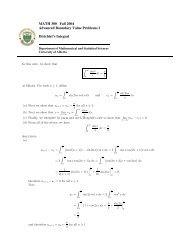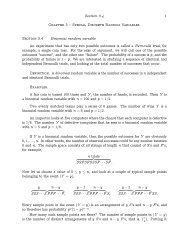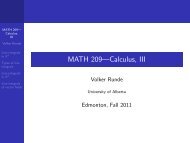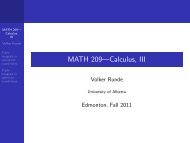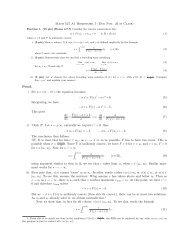Math 411: Honours Complex Variables - University of Alberta
Math 411: Honours Complex Variables - University of Alberta
Math 411: Honours Complex Variables - University of Alberta
Create successful ePaper yourself
Turn your PDF publications into a flip-book with our unique Google optimized e-Paper software.
holds over C. We obtain:<br />
�<br />
∞�<br />
z<br />
exp(z)exp(w) =<br />
j=0<br />
j<br />
��<br />
∞�<br />
j!<br />
k=0<br />
∞� n� z<br />
=<br />
n=0 k=0<br />
n−k<br />
(n−k)!<br />
∞� n�<br />
�<br />
1 n<br />
=<br />
n! k<br />
n=0 k=0<br />
n� (z +w)<br />
=<br />
n<br />
n!<br />
n=0<br />
= exp(z +w).<br />
wk �<br />
k!<br />
w k<br />
k!<br />
�<br />
z n−k w k<br />
15<br />
by the Cauchy product formula, letting n = j +k,<br />
We call exp: C → C the exponential function. The above property suggests<br />
using the shorthand e z for exp(z). An interactive three-dimensional graph <strong>of</strong><br />
exp(z) is shown in Figure 3.1.<br />
3. The sine and cosine functions on C are defined as<br />
and<br />
sin(z) :=<br />
cos(z) :=<br />
∞�<br />
n=0<br />
(−1) n z 2n+1<br />
(2n+1)!<br />
∞�<br />
(−1)<br />
n=0<br />
n z2n<br />
(2n)!<br />
for z ∈ C. As for exp(z), we see that both sin(z) and cos(z) converge absolutely<br />
for all z ∈ C. Moreover, we have for z ∈ C:<br />
e iz ∞� (iz)<br />
=<br />
n=0<br />
n<br />
n!<br />
∞� (iz)<br />
=<br />
n=0<br />
2n<br />
(2n)! +<br />
∞� (iz)<br />
n=0<br />
2n+1<br />
(2n+1)!<br />
∞�<br />
n z2n<br />
= (−1)<br />
(2n)! +i<br />
∞�<br />
(−1) n z2n+1 (2n+1)!<br />
n=0<br />
= cos(z)+isin(z).<br />
Interactive three-dimensional graphs <strong>of</strong> the complex cosine and sine functions<br />
are shown in Figures 3.2, and 3.3.<br />
n=0



